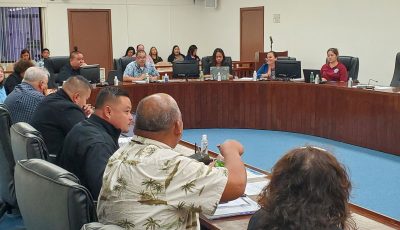PSS employees undergo training on preparing for a crisis

PSS Mental Health Project HALIGI AWARE conducts a three-Day NASP PREPaRE Workshops to enhance crisis preparedness in the CNMI Public School System. (CONTRIBUTED PHOTO)
The CNMI Public School System’s Mental Health Project HALIGI AWARE recently held a workshop for over 80 school counselors, principals, and administrative staff to better prepare them for catastrophic and disastrous crises and events.
The workshop, called NASP PREPaRE Workshop 1 and 2, 3rd Edition, was held on April 11-13, 2023, and was presented by a team that included Frank Lee Borja, Janice Muña, Dr. Bobby James A. Cruz, Bonny Grow, Audrey King, and Dr. Jennifer Maratita.
During the three-day workshop, the attendees were introduced to the PREPaRE model, a plan that includes five areas of preparedness: prevention, protection, mitigation, response, and recovery. It is designed to align with best practices specific for schools in times of crises, and is conducted in collaboration with the Department of Education, Federal Emergency Management Agency, and U.S. Department of Homeland Security.
The workshop also emphasized the importance of having a comprehensive approach within the Incident Command System to respond to multiple emergencies.
The PREPaRE workshop adopts a trauma-informed response to crisis scenarios specific to the unique needs of each school.
Borja, PSS Mental Health LEA community manager, emphasized the importance of establishing and sustaining comprehensive school safety, crisis prevention, and preparedness with a focus on balancing physical and psychological safety.
Workshop participants found the training beneficial. Elvielynn S. Calvo, a school counselor, said the training increased her knowledge and skills, “equipping me with evidence-based strategies to provide appropriate services to students, teachers, and families who have experienced trauma. Additionally, the group discussions and tabletop exercises allowed me to learn from my colleagues and grow collaboratively as a professional.”
The attendees were trained on the different steps of the PREPaRE model, which included prevention and preparedness for crises, reaffirmation of physical health and welfare, evaluation of psychological trauma risks, delivery of crisis interventions, targeted response of mental health needs, and examination of the effectiveness of crisis preparedness.
The trainers also discussed vulnerability assessments and functional annexes such as security, lockdown, evacuation, communication and family reunification. Participants learned about the importance of multidisciplinary teams, collaboration with partners and value of practice through orientations, drills, and tabletop exercises.
Kagman High School principal Ben Jones said the training is a proven framework that he plans to continue to implement into the KHS Emergency Operation Plan. “Having meaningful tabletop exercises and conducting drills is one way we can implement the PREPaRE strategies. A quote that I try to live by is ‘plan your practice, practice your plan.’”
PREPare authors shared that, while school crisis prevention should always be the goal, it must be acknowledged that it is just a matter of time before all schools need to respond to crises. Further, recent events have reminded us that school associated crises can quickly overwhelm available resources. The NASP PREPaRE curriculum provides guidance on how to prevent, protect, mitigate, respond, and recover from crisis events. (PR)



























